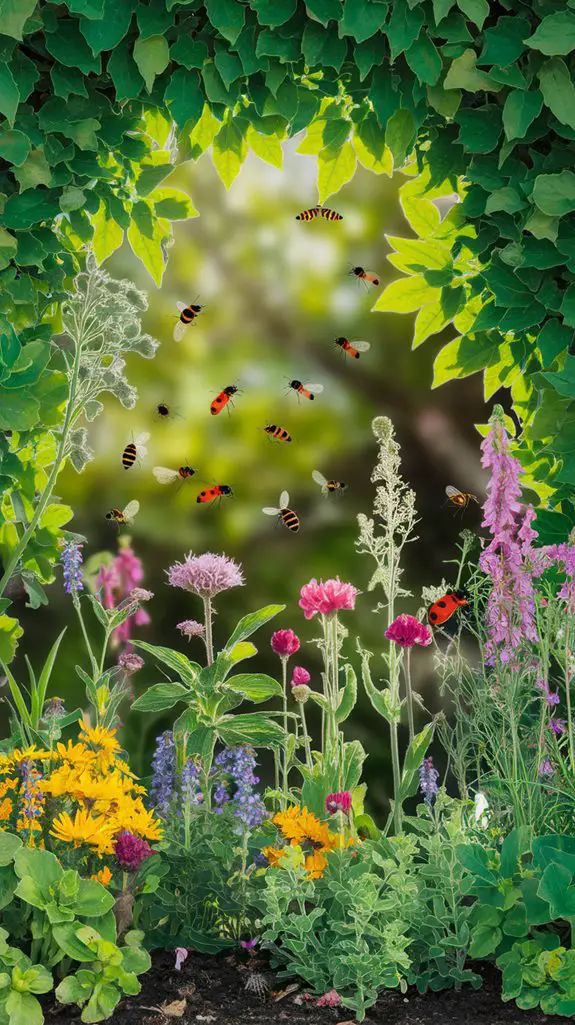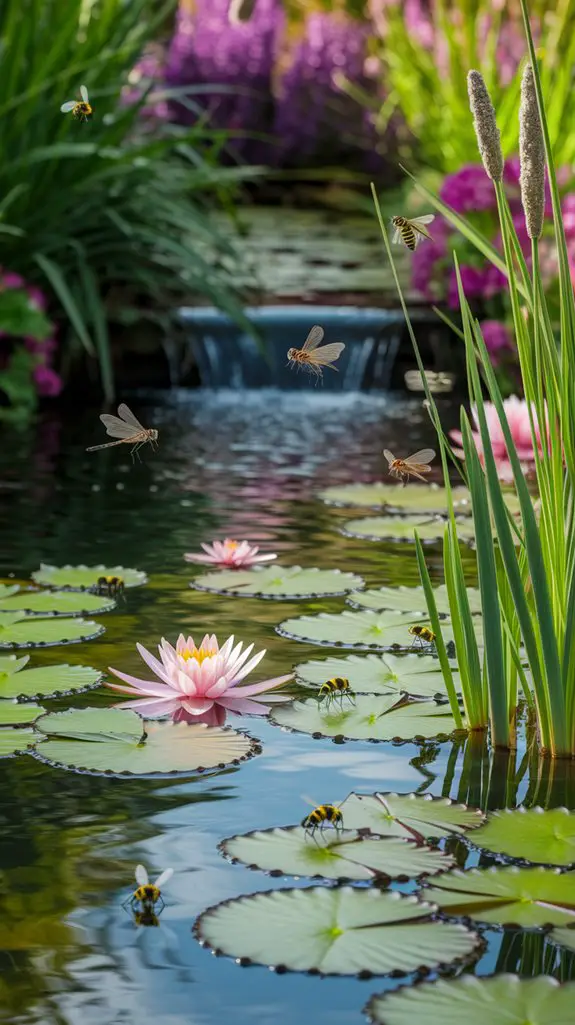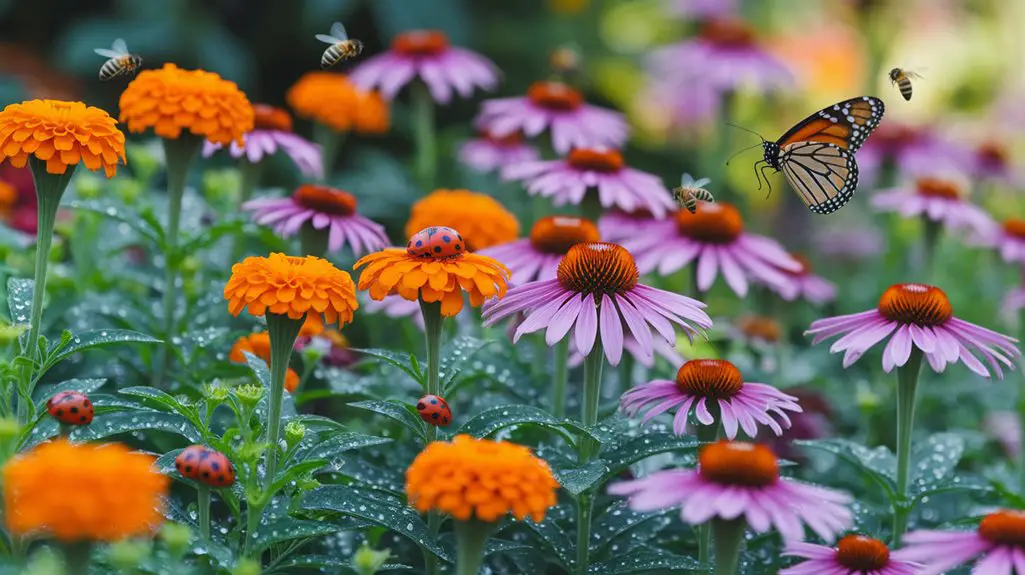Did you know that over 90% of flowering plants rely on insect pollinators for reproduction? Your garden’s ecosystem functions as a microcosm of nature’s intricate relationships, where beneficial insects serve as both pollinators and natural pest controllers. When you cultivate specific plant families like Asteraceae (daisies, sunflowers) and Lamiaceae (mints, salvias), you’re setting the stage for a balanced arthropod community. The secret to attracting these helpful allies lies in understanding their specific habitat requirements and food sources.
Native Flowering Plants That Entice Helpful Insects
While many gardeners focus primarily on plant selection for aesthetic purposes, native flowering plants serve as essential habitat elements that support diverse beneficial insect populations.
Species in the Asteraceae family—including Echinacea, Rudbeckia, and Aster—produce abundant pollen and nectar that attract parasitoid wasps and predatory flies with their compound flower structures.
Lamiaceae members, like Monarda and Agastache, feature tubular corollas perfectly adapted to pollinators with specialized mouthparts.
You’ll find syrphid flies hovering near Pycnanthemum (mountain mint), where they lay eggs that develop into aphid-consuming larvae.
Consider incorporating Asclepias (milkweed) species, which host monarch butterflies while attracting lacewings that prey on garden pests.
Select varieties with sequential bloom periods to guarantee continuous nectar availability throughout growing seasons.
Additionally, creating a wildlife-friendly garden can enhance the ecological balance by providing habitats for a variety of beneficial insects.
Creating Habitat Diversity for Insect Allies

Beyond flowering plants, beneficial insects require diverse microhabitats that accommodate their complex life cycles and behavioral needs.
You’ll need stratified vegetation zones—ground covers, mid-story shrubs, and canopy layers—to support different feeding guilds and hunting styles.
Include:
- Undisturbed soil patches for ground-nesting Hymenoptera
- Leaf litter for Carabid beetles and detritivores
- Standing deadwood for xylophagous Coleoptera
- Rock piles for thermoregulating Coccinellidae
- Shallow water sources for Odonata reproduction
- Bunch grasses for overwintering Chrysopidae
Don’t over-maintain your garden.
Hollow stems from last season’s growth shelter Osmia spp., while bare soil patches allow Cicindelidae to construct larval burrows. Additionally, providing pollinator-friendly habitats can further enhance the diversity and abundance of beneficial insects in your garden.
These microhabitat elements create ecological continuity, ensuring your beneficial insect population remains stable through phenological changes and climatic fluctuations.
Water Features That Draw Beneficial Insects

Water features constitute critical infrastructure within beneficial insect habitats, providing essential services beyond mere hydration.
You’ll observe syrphid flies, lacewings, and parasitoid wasps visiting shallow water sources where they can safely land and drink without drowning. Implement varied aquatic microhabitats—small pebble-lined depressions, clay saucers with gradual edges, or botanical birdbaths containing partially submerged stones.
Morning dew collection surfaces benefit minute Trichogramma wasps (0.5-0.8mm), while larger puddles attract predaceous diving beetles (Dytiscidae).
Position water features near flowering plants to create complete resource islands. During summer’s peak, these hydration stations become congregation points for Odonata (dragonflies, damselflies), voracious mosquito predators that require water for reproduction. Additionally, incorporating natural water sources provides a more sustainable environment for these insects.
Maintaining year-round water access guarantees continuous beneficial insect presence, even during seasonal population fluctuations.
Shelter Elements to Keep Helpful Bugs Year-Round
Creating permanent shelter structures guarantees beneficial insect populations persist throughout seasonal changes rather than recolonizing annually. These refugia serve as overwintering sites for predatory beetles, parasitoid wasps, and pollinating hymenoptera. Additionally, incorporating native plants into your landscape can further enhance habitat suitability for these important insects.
| Shelter Type | Beneficial Inhabitants |
|---|---|
| Insect hotel | Mason bees, leafcutter wasps |
| Rock pile | Ground beetles, spiders |
| Brush pile | Lacewings, ladybird beetles |
| Leaf litter | Carabid beetles, centipedes |
Incorporate these structures at garden peripheries, positioning them to receive morning sunlight and afternoon shade. For hymenoptera, drill 3-8mm diameter holes in untreated wood blocks or bundle hollow stems. Maintain 15% of your landscape as undisturbed habitat with native bunch grasses. Chrysopidae and Coccinellidae particularly benefit from these microhabitats during dormancy periods.
Avoiding Harmful Pesticides in Your Garden
Chemical pesticides, while seemingly effective for immediate pest control, drastically reduce beneficial arthropod populations through both direct toxicity and food web disruption.
These synthetic compounds lack target specificity, eliminating predatory Coccinellidae (ladybugs), parasitoid Hymenoptera, and pollinating Apoidea indiscriminately alongside pest species.
To maintain a thriving beneficial insect community:
- Adopt integrated pest management (IPM) protocols, prioritizing cultural and biological controls before chemical interventions
- Select botanical insecticides with shorter residual periods, such as pyrethrin or neem oil, when intervention becomes necessary
- Implement targeted application methods like soil drenches or spot treatments rather than broad foliar spraying
- Time applications for evening hours when most pollinators have returned to nesting sites and beneficial predators exhibit reduced activity
Additionally, creating habitat diversity in your garden can further attract beneficial insects and enhance their populations.
This selective approach preserves ecological balance while still managing problematic pest populations effectively.
Companion Planting Strategies for Insect Management
Companion planting, an ancient agricultural practice dating back to indigenous polycultures, strategically positions plant species to create mutually beneficial relationships that disrupt pest life cycles and attract beneficial arthropods.
Interplant Apiaceae species (dill, fennel, carrot) to attract parasitoid wasps (Braconidae, Ichneumonidae) with their umbel-shaped inflorescences.
Asteraceae members like cosmos and zinnias provide landing platforms for hover flies (Syrphidae), whose larvae consume aphids.
Position aromatic Lamiaceae plants (basil, oregano) to repel herbivorous pests through volatile terpenes while supporting pollinators.
You’ll achieve ideal results by creating plant guilds—functional groups that complement each other’s defensive chemistry.
Marigolds (Tagetes) exude thiopene from their roots, deterring soil nematodes, while tall sunflowers serve as “trap crops,” diverting pest attention from your valuable cultivars. Additionally, incorporating companion planting techniques can enhance biodiversity in your garden, creating a more resilient ecosystem.
Seasonal Considerations for Attracting Beneficial Insects
While companion planting establishes foundational insect relationships, the dynamic seasonality of your garden’s ecosystem requires thoughtful planning throughout the year’s phenological windows.
Synchronize your cultivation practices with insect life cycles to maximize beneficial population establishment and persistence.
- Early spring: Provide nectar-rich Apiaceae and Brassicaceae to support syrphid flies (Syrphidae) emerging from overwintering when aphid populations begin expanding.
- Late spring: Establish composite flowers (Asteraceae) with exposed nectaries to attract parasitoid wasps (Ichneumonidae, Braconidae) during their peak oviposition period.
- Summer: Maintain umbel-bearing plants (Apiaceae) with shallow corollas accessible to predatory insects with short proboscises, such as minute pirate bugs (Anthocoridae).
- Autumn: Preserve seed heads and hollow stems as overwintering habitat for predatory beetles (Carabidae) and solitary bees (Megachilidae). Additionally, incorporating habitat diversity can significantly enhance the overall appeal of your garden to beneficial insects.
The Top Predatory Insects and How to Welcome Them
Among the garden’s most effective biocontrol agents, predatory insects form the vanguard of natural pest management through their voracious consumption of herbivorous pests.
Prioritize Coccinellidae (ladybugs), recognizable by their convex, spotted elytra, which devour aphids at rates exceeding 50 daily.
Chrysopidae (lacewings), with their diaphanous wings and elongated abdomens, contribute markedly—their larvae, armed with sickle-shaped mandibles, consume mites, thrips, and scale insects.
To attract these allies, establish Apiaceae (dill, fennel) and Asteraceae (coneflowers, cosmos) throughout your garden.
You’ll need persistent water sources—shallow dishes with emergent stones.
Avoid broad-spectrum insecticides that decimate beneficial populations indiscriminately.
Instead, incorporate permanent refugia—undisturbed perennial plantings and unmulched areas—where these predators can complete their life cycles unimpeded. Additionally, introducing seasonal herbs can further enhance the habitat for these beneficial insects.
Measuring Success: Signs Your Garden Is an Insect Haven
Evaluating whether your efforts to create an insect sanctuary have succeeded requires systematic observation of specific bioindicators throughout the growing season.
You’ll notice gradual changes in both diversity and abundance of arthropod fauna as your garden’s ecological balance improves.
Look for these key indicators:
- Balanced populations—predator-prey ratios stabilize, with syrphid larvae controlling aphids without complete elimination
- Soil arthropod proliferation—increased centipedes, pseudoscorpions, and collembola beneath leaf litter, indicating healthy decomposition pathways
- Pollinator diversity—beyond honeybees to include native bees, butterflies, and specialized pollinators like Ceratina spp.
- Reduced pest damage—plants exhibit minimal herbivory despite decreased pesticide use
When you observe these patterns consistently across multiple seasons, you’ve created a functional ecological network capable of self-regulation through trophic interactions, enhancing overall garden resilience.
Conclusion
Your garden, like a bustling metropolis, thrives when diverse inhabitants fill specialized niches. You’ll witness Coccinellidae patrolling aphid colonies while Chrysopidae larvae, with their sickle-shaped mandibles, hunt among your Echinaceae purpurea. It’s not merely plantings but interconnected ecosystems you’re cultivating—refugia, hibernacula, and moisture gradients all supporting trophic relationships. By fostering this intricate web, you’re not growing plants; you’re orchestrating biotic resilience.




